














|
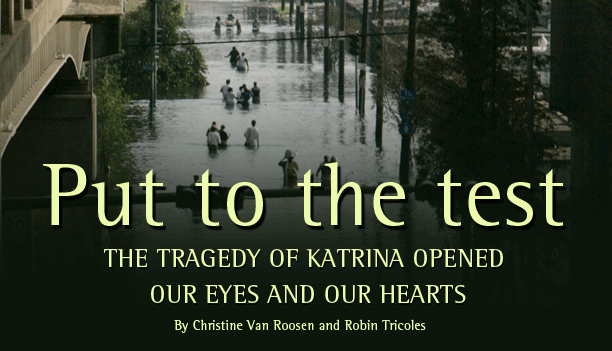 |
| |
|
|
|
 |
When
Hurricane Katrina hit the Gulf Coast the Sunday before Labor Day,
faculty, staff, and students in the Woodruff Health Sciences Center
mobilized quickly to offer assistance. Physicians
and nurses worked around the clock tending to evacuated patients
at hospitals, clinics, and emergency shelters. Nursing and public
health students met flights at Dobbins Air Reserve Base. Administrators
spent hours on the phones trying to relocate medical, nursing, and
public health students from institutions in Mississippi and Louisiana
that were closed indefinitely due to storm damage. Social workers
and pastoral counselors helped families locate loved ones and offered
patients a chance to talk about their experiences. The human resources
department at Emory Healthcare helped organize a job fair for evacuees
looking for work in the Atlanta area.
Countless others collected clothing,
food, and cleaning supplies to distribute to people who lost everything
in the storm. For both the hurricane’s victims and those who
worked to help them, that weekend changed their lives forever.
On the following pages, a few of Emory’s volunteers recall
the experience in their own words. |
 |
| |
|
|
|
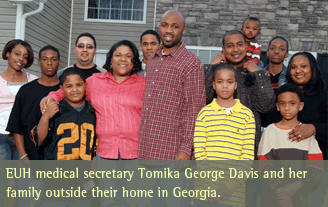
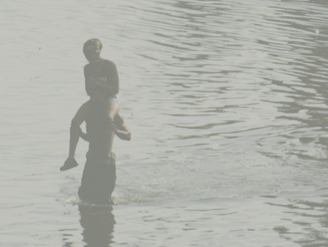 |

| |
 |
|
 |
“Nearly
every single year, New Orleans has been evacuated because
of a hurricane, and nothing terrible ever happened. That’s
why a lot of people didn’t evacuate. We haven’t
seen anything like this since I’ve been alive.
“The Saturday night before it hit, we got a call
from my cousin asking if he could come up and stay. I didn’t
know until then that Katrina was even in the Gulf. . . . During
the first weekend, we ended up with 13 people staying. The
second week we had 15 people. We had just moved into our home
in May, our first home. Now we have people sleeping on air
mattresses all over the place. Some of my family members lost
homes—lost everything. It’s a very trying time
now, very trying.”— Tomika George
Davis, a medical secretary at Emory University Hospital,
is from New Orleans. |
 |
| |
|
|
|
| |
 |
| |
| |
|
 |
 |

“The first day or two at the
North Druid Hills shelter, we saw exhausted people who were out
of their medicine, dehydrated from diarrhea, or had insomnia.
We had a few cases of bronchitis, cough, and cold. Outside
of medical needs, people also needed to decompress. They had had
horrendous experiences. They wanted to “see the doctor,”
but they really just needed to tell their stories.
I think people now realize they could
be easily overwhelmed with a regional natural disaster or a terrorist
attack. Health care leaders within a day’s drive of the emergency
will need to do shelter needs assessments, aggressively recruit
a large group of volunteers, and set up a volunteer schedule to
avoid volunteer burnout.” — Charles Harper,
Emory medical faculty member and director of Grady Hospital’s
Urgent Care Center. Harper recruited volunteer nurses and residents
at Grady, doubling the center’s staffing to handle the influx
of evacuees. After the initial rush was over, he coordinated medical
volunteers at the Salvation Army shelter on North Druid Hills Road. |
 |
| |
 |
|
|
| |
|
|
|
| |
|
 |
| |
 |
|
|
 |
“First,
we were told we were going to a field hospital in Alexandria, which
is just north of Baton Rouge. But when we got
to the special needs shelter, it was nursing home patients, and
we were prepared to be treating trauma and critical care patients.
We ended up working a 12-hour shift there, organizing their supplies
and talking with the evacuees. But we still felt we were really
needed somewhere else. So paramedics with an ambulance stationed
just outside the shelter offered to take us back to the emergency
operation command center in Baton Rouge.
We got there at 3 am and slept on
army cots. The volunteers there tried to find us places as nurses,
and they couldn’t. I was starting to get frustrated. So we
talked with some other paramedics and told them we’d like
to go to New Orleans. I told them we were three misplaced critical
care nurses and asked if they could take us with them.
I think the fundamental problem was
that there were so many different agencies working independently,
the Red Cross, FEMA, the Louisiana Department of Public Health,
and the military.
Even so, I am so glad I went. This
whole experience made me reevaluate my life. I’m so thankful
for my family. And I’m so thankful for what I have.”
—Emory Hospital research nurse Michelle Uhl
volunteered for an Angel Flight mission to Louisiana in the storm’s
immediate aftermath. |
 |
| |
 |
|
|
| |
|
|
|
| |
|
 |
| |
 |
|
|
 |
“I
was just so struck by the devastation—knowing that people
had lost everything. I
remember one couple had floated their baby in a waterproof container
as they walked through the contaminated water, so she wasn’t
sick when she arrived.
I was really proud of Emory’s
response, and I was grateful for the spirit of the people with whom
I worked. I’m a nurse midwife so I don’t normally think
about emergencies at this level. The coordination and communication
that I saw was incredible.”—Maureen Kelley,
chair of the Department of Family and Community Nursing
at the nursing school. Kelley worked at Red Cross Service Centers
over Labor Day weekend and later helped coordinate nursing volunteers
at the Salvation Army shelter on North Druid Hills Road. |
 |
| |
 |
|
|
| |
|
|
|
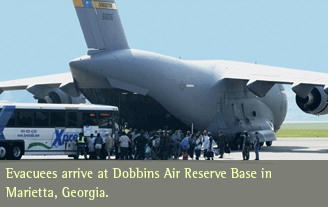
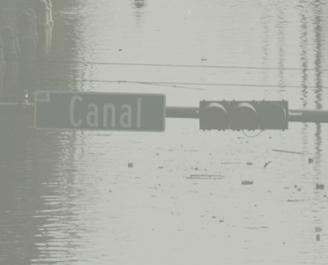 |

| |
|
|
 |
“We
deal with sudden illness, death, and grief every day.
But Katrina victims’ problems were complicated by
disorientation. One woman told me, ‘I feel like I’ve
been kidnapped.’ She had been picked up off the top
of a hospital and put in a C5A [military transport plane].
The next thing she knew, she was in Atlanta in an ambulance
coming to Emory Hospital.
We saw every evacuee for the
first 72 hours in each hospital. We helped them reconnect
with relatives and discover their own spiritual and coping
resources to deal not only with the flood and evacuation,
but their medical issues. Many chaplains and social services
people helped evacuees who couldn’t stand in housing
lines—even securing efficiency apartments for long-term
needs.”— Woody Spackman,
executive director, Clinical Pastoral Services, Emory Healthcare. |
 |
| |
|
|
|
| |
|
|
|
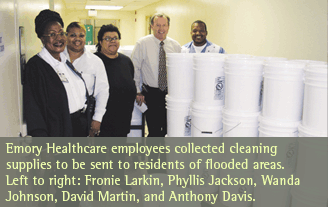
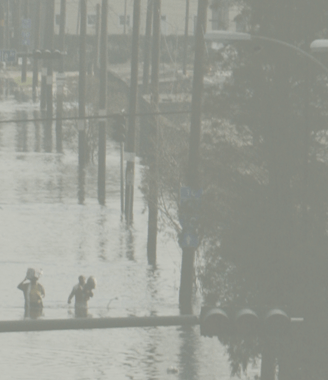 |

| |
|
|
 |
“With
Katrina, we learned that there’s no textbook approach
in dealing with disasters. There are certain
principles of disaster planning, and you can know and follow
those principles, those techniques, those interventions. But
really, there’s no set approach to address every situation,
no matter how you prepare. . . . One of our biggest challenges
was identifying patients. I interviewed a woman who could
not remember if she had come from a nursing home or if she
had had recent surgery. She couldn’t give her date of
birth or address. Her mind was fuzzy from the event. So in
those cases where patients couldn’t give us any identification,
we had to use any available technology to identify a person,
including the web.
There were years when I was
at the bedside, especially early on in my career. And it’s
not that I never do that now, because I frequently do. But
Katrina was different because we knew that each patient had
gone through such a horrible experience.” —Mary
Alice Merrill, director of Utilization Review and
Social Services for Emory Hospitals. |
 |
| |
|
|
|
| |
|
|
|
 |
| |
|
|
|
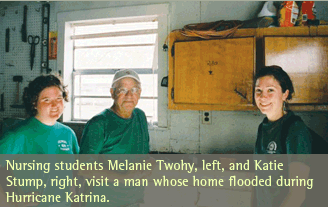
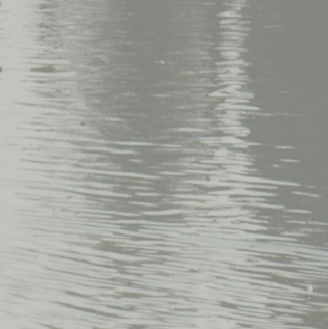 |

| |
|
|
 |
“I
can’t describe the natural adrenaline I get when I hand
a baby doll to a 3-year-old girl who has lost all her toys.
Or what it is like to stand next to a rubbish pile with someone
who pulls out their old photo album from it and starts to
show you each picture, water running across it blurring the
image, but the picture obviously still so vivid in their head
and heart.
How can we laugh and smile with
people who have lost so much? I don’t know. Perhaps
grace. Perhaps hope. Perhaps the value of love and family
that keeps so many of them going. There is so much to be done,
but it’s the little things that keep hope coming. I
hope that’s what we were able to share. And I hope what
I gave was greater than all that I gained through this experience.
—From an email to friends and family by nursing
student Crystal Bailey. Bailey and fellow
students Melanie Twohy and Katie
Stump went to New Orleans over the school’s
fall semester break to help with recovery efforts. |
 |
| |
|
|
|
| |
|
|
|
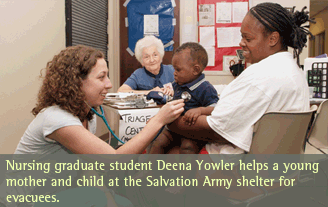
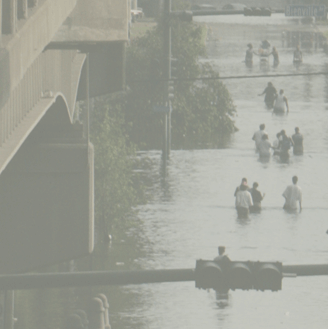 |

| |
|
|
 |
“We
increased our staffing at Crawford Long to take care of additional
patients, some of whom arrived in the middle of the night.
Essentially, we had 24/7 coverage. In addition to their regular
shifts, a few of the staff came in at 5:00 in the morning
to do admissions and to help out, and others even volunteered
to be on call. We had an extra team in the daytime, and we
had an extra physician on call at night.”
“I think the Emory community
quickly realized how rapidly they could put together a very
coherent and cohesive approach to delivering care to the evacuees.
It was quite stunning. And I think this is critical: Emory
was proactive in responding to Katrina. They were not reactive.
It was not, ‘Let’s wait and see.’ But rather,
‘We need to be ready.’ —Mark
Williams, director of the hospitalist program at
Emory Healthcare. Williams helped organize Team Katrina—a
group of
hospital-based physicians who worked around the clock to provide
immediate care to evacuees. |
 |
| |
|
|
|
| |
|
|
|
| |
|
 |
| |
 |
|
|
 |
“I
learned a lot from this experience. I lived in New York during September
11th, so this to me was a similar event.
And I worked for the U.S. fund for UNICEF for seven years before
coming here, so emergency response was something I knew how to do.
But I’ve never been in the position
where I had to coordinate, strictly from a medical perspective,
such a variety of needs. One gentleman had been treading water for
four or five hours in downtown New Orleans and then walked for two
days to get out.
You know, New York City had
a disaster management plan for a very long time, but it was in theory
only. Galveston, Houston, New Orleans, and the Florida panhandle,
I’m sure, all have evacuation plans, in theory. But they’re
not necessarily plans that have been updated or maintained or practiced.
We need to practice. Otherwise, how can we move 40,000 people out
of a town or evacuate 2,400 ICU patients overnight? —Wendy
Rhein, the School of Nursing’s director of service
learning. Rhein coordinated the nursing response at the Salvation
Army shelter for evacuees on North Druid Hills Road. The university
committed to providing around-the-clock nursing support to the shelter
while it remained open. |
 |
| |
 |
|
|
| |
|
|
|
| |
Christine van Roosen is
a freelance writer in Atlanta. Robin Tricoles is the managing editor
of the Journal of Hospital Medicine. |
|
| |
|
|
|
|
|





